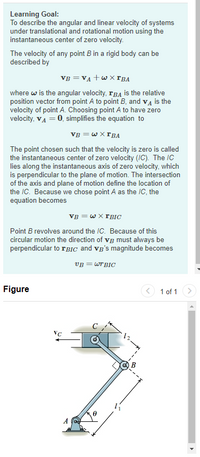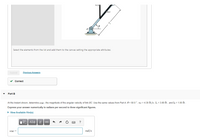
Elements Of Electromagnetics
7th Edition
ISBN: 9780190698614
Author: Sadiku, Matthew N. O.
Publisher: Oxford University Press
expand_more
expand_more
format_list_bulleted
Concept explainers
Question
thumb_up100%
- once answered Correctly will UPVOTE!!

Transcribed Image Text:Learning Goal:
To describe the angular and linear velocity of systems
under translational and rotational motion using the
instantaneous center of zero velocity.
The velocity of any point B in a rigid body can be
described by
VB = VA +w X rBA
where w is the angular velocity, rBA is the relative
position vector from point A to point B, and vĄ is the
velocity of point A. Choosing point A to have zero
velocity, VA = 0, simplifies the equation to
VB = w X FBA
The point chosen such that the velocity is zero is called
the instantaneous center of zero velocity (IC). The IC
lies along the instantaneous axis of zero velocity, which
is perpendicular to the plane of motion. The intersection
of the axis and plane of motion define the location of
the IC. Because we chose point A as the IC, the
equation becomes
VB = wX FBIC
Point B revolves around the IC. Because of this
circular motion the direction of vg must always be
perpendicular to 1BIC and vg's magnitude becomes
VB = WTBIC
Figure
1 of 1
VC

Transcribed Image Text:ICIO
VBIC
Select the elements from the list and add them to the canvas setting the appropriate attributes.
Submit
Previous Answers
v Correct
Part B
At the instant shown, determine wBC, the magnitude of the angular velocity of link BC. Use the same values from Part A: 0 = 50.0 ° , vc = 4.30 ft/s, l1 = 3.80 ft , and l2 = 1.00 ft .
Express your answer numerically in radians per second to three significant figures.
• View Available Hint(s)
vec
WBC =
rad/s
Expert Solution
This question has been solved!
Explore an expertly crafted, step-by-step solution for a thorough understanding of key concepts.
This is a popular solution
Trending nowThis is a popular solution!
Step by stepSolved in 2 steps with 3 images

Knowledge Booster
Learn more about
Need a deep-dive on the concept behind this application? Look no further. Learn more about this topic, mechanical-engineering and related others by exploring similar questions and additional content below.Similar questions
- In a positive angle, the terminal side inclines _____________ from the initial side.arrow_forwardThe name given to a machine that violates the laws of Thermodynamics is called a , while that that violated the second law of thermodynamic is called a and that that violates the first law of thermodynamics is called a NB: write answers in words and not abbreviation.arrow_forwardDetermine the number of fully rotating cranks in the planar mechanisms shown below. Show your calculations.arrow_forward
arrow_back_ios
arrow_forward_ios
Recommended textbooks for you
 Elements Of ElectromagneticsMechanical EngineeringISBN:9780190698614Author:Sadiku, Matthew N. O.Publisher:Oxford University Press
Elements Of ElectromagneticsMechanical EngineeringISBN:9780190698614Author:Sadiku, Matthew N. O.Publisher:Oxford University Press Mechanics of Materials (10th Edition)Mechanical EngineeringISBN:9780134319650Author:Russell C. HibbelerPublisher:PEARSON
Mechanics of Materials (10th Edition)Mechanical EngineeringISBN:9780134319650Author:Russell C. HibbelerPublisher:PEARSON Thermodynamics: An Engineering ApproachMechanical EngineeringISBN:9781259822674Author:Yunus A. Cengel Dr., Michael A. BolesPublisher:McGraw-Hill Education
Thermodynamics: An Engineering ApproachMechanical EngineeringISBN:9781259822674Author:Yunus A. Cengel Dr., Michael A. BolesPublisher:McGraw-Hill Education Control Systems EngineeringMechanical EngineeringISBN:9781118170519Author:Norman S. NisePublisher:WILEY
Control Systems EngineeringMechanical EngineeringISBN:9781118170519Author:Norman S. NisePublisher:WILEY Mechanics of Materials (MindTap Course List)Mechanical EngineeringISBN:9781337093347Author:Barry J. Goodno, James M. GerePublisher:Cengage Learning
Mechanics of Materials (MindTap Course List)Mechanical EngineeringISBN:9781337093347Author:Barry J. Goodno, James M. GerePublisher:Cengage Learning Engineering Mechanics: StaticsMechanical EngineeringISBN:9781118807330Author:James L. Meriam, L. G. Kraige, J. N. BoltonPublisher:WILEY
Engineering Mechanics: StaticsMechanical EngineeringISBN:9781118807330Author:James L. Meriam, L. G. Kraige, J. N. BoltonPublisher:WILEY

Elements Of Electromagnetics
Mechanical Engineering
ISBN:9780190698614
Author:Sadiku, Matthew N. O.
Publisher:Oxford University Press

Mechanics of Materials (10th Edition)
Mechanical Engineering
ISBN:9780134319650
Author:Russell C. Hibbeler
Publisher:PEARSON

Thermodynamics: An Engineering Approach
Mechanical Engineering
ISBN:9781259822674
Author:Yunus A. Cengel Dr., Michael A. Boles
Publisher:McGraw-Hill Education

Control Systems Engineering
Mechanical Engineering
ISBN:9781118170519
Author:Norman S. Nise
Publisher:WILEY

Mechanics of Materials (MindTap Course List)
Mechanical Engineering
ISBN:9781337093347
Author:Barry J. Goodno, James M. Gere
Publisher:Cengage Learning

Engineering Mechanics: Statics
Mechanical Engineering
ISBN:9781118807330
Author:James L. Meriam, L. G. Kraige, J. N. Bolton
Publisher:WILEY